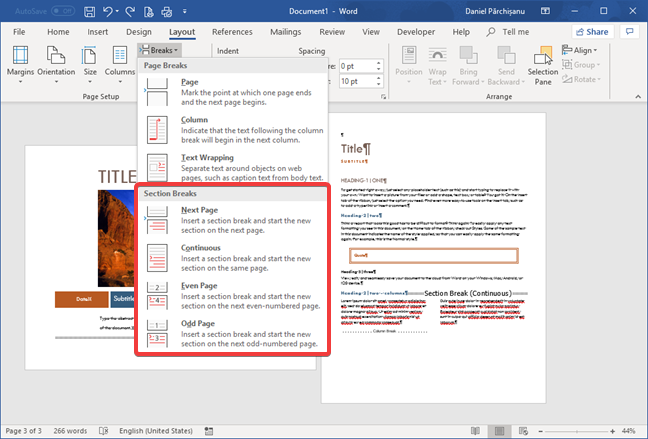

You'll be able to move any page into any spot. Then instead of creating page breaks create section breaks. You still want to do word processing but you want each page to be a separate item and you want them to be able to move around. If you're doing the kind of thing where, say, you don't want to do a page layout document. Likewise I can grab page four, and that's a section by itself, and I can move that before section one or after section three. So I can grab any page in the first section here, see they group together and it says three there, and I can actually move section one around. Another thing you can do is you can drag and drop sections here in the thumbnails on the left. That's one way sections are very different than pages. So you can actually have different page numbering and different Headers and Footers on each section. How page numbering works, that kind of thing. If I go to Document, the Document sidebar and hit Section, which I've had open here, there are a bunch of different things that change by section.įor instance, like Headers and Footers. Page four is section two and page five is section three. So pages one, two, and three are part of section one. One after page three, one after page four. Section breaks are a lot more complex because each section you create, and now there are three sections, I've added three section breaks. Page breaks, as I've said, are very simple. Well there are a bunch of differences between section breaks and page breaks. I can use the back arrow here and I can see there's that character there at the end of page four. That's handy but it seems to be doing the same thing.

Clears the rest of the page and I go to the next page which I'll call four. Now I'm going to use the back arrow key, the left arrow key here, to go back and you can see I've got what looks like a page break character here, because I still have Show Invisible, right, but it's a little bit of a different icon showing me it's a Section Break and not a Page Break. So at the end of page three here I'm going to insert a Section Break. If that's your goal then Page Breaks aren't what you want. Now what about being able to arrange pages. So think of it as this extra character that is there. So by deleting it I get rid of it there and I've merged the two pieces of text on those two pages there.

The previous character if the page break. Now if I were to Delete it would delete the previous character. As a matter of fact if you wanted to get rid of it I could simply use the forward arrow here, you can see I'm just before this line break there, I go to the next line, you can see I'm just before the page break and I forward arrow again and I go to the beginning of the next page. It's really useful to think of this as actual physical character on the page because it really is one. I can go to the next page and you can see there's the one there and the next page here I don't have one there at the end there. They're this blue line here and a little page at the end. Like here are the returns and paragraph breaks after each line. Show Invisibles will actually show things. Let's take a look by going to View and Show Invisibles. It's still basically one long piece of text with page breaks in there. That's because pages are always sequential. With the thumbnails here on the left they try to drag them and they find out they can't drag it and it's very frustrating. They say, well you know I want three and two to be switched. One thing that people have trouble with a lot, when dealing with multiple pages like this and with page breaks, is they want to rearrange things. Really the only thing they do is basically say clear the rest of the page and jump to the beginning of the very next page. In page two here, let me type the word two and a few blanks lines, and I can go back and forth between one and two. So you can see clearly I've got page one and page two. I have also shrunk it a bit here by dragging the divider. Now I have View, and Show Page Thumbnails turned on. So I have this stuff on page one and this on page two. Basically what you're saying is after this point everything is going to start on the very next page. You insert that and it jumps to the next page. Now here under Insert I have both Page Break and Section Break. Let me just type the word one here on the first page. So I have a blank document here and I can insert some text. These things only really apply to word processing documents, not page layout documents like brochures and flyers and things like that. Here I have a blank word processing document in Pages. Video Transcript: When working in Pages it's important to understand both page break and section breaks. Check out Understanding Page and Section Breaks in Pages at YouTube for closed captioning and more options.


 0 kommentar(er)
0 kommentar(er)
